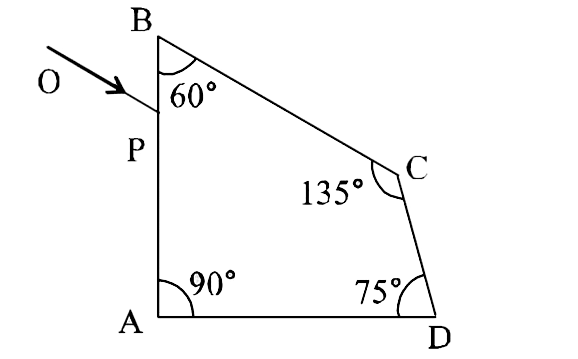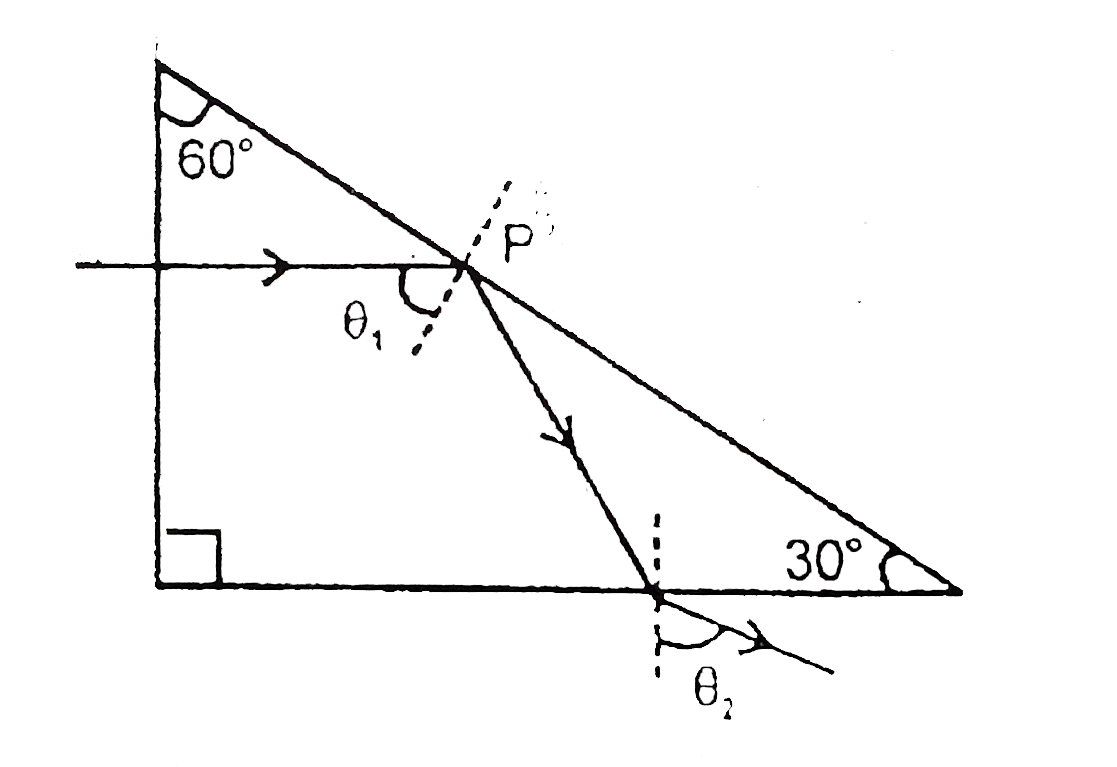The maximum refractive index of a material, of a prism of apex 90∘ , for which light may be transmitted is
√3
1.5
√2
none of these
The correct Answer is:B
To find the maximum refractive index of a material of a prism with an apex angle of 90∘, we can follow these steps:
1. Understanding the Prism Configuration:
- We have a prism with an apex angle A=90∘.
- When light enters the prism, it refracts at the first surface and then refracts again at the second surface.
2. Using the Refractive Angles:
- Let r1 be the angle of refraction at the first surface and r2 be the angle of refraction at the second surface.
- According to the geometry of the prism, we have:
r1+r2=A=90∘
3. Critical Angle Condition:
- For light to be transmitted through the prism, the angles of refraction must not exceed the critical angle θc for the material of the prism.
- Since r1=r2=θc at maximum refractive index, we can set:
r1=r2=θc
4. Setting Up the Equation:
- From the equation r1+r2=90∘, substituting r1 and r2 gives:
θc+θc=90∘⟹2θc=90∘⟹θc=45∘
5. Using the Critical Angle Formula:
- The critical angle is related to the refractive index n of the material by the formula:
sin(θc)=1n
- Substituting θc=45∘:
sin(45∘)=1n
- Since sin(45∘)=1√2:
1√2=1n
6. Solving for the Refractive Index:
- Rearranging the equation gives:
n=√2
Final Answer:
The maximum refractive index of the material of the prism is n=√2.
---
- We have a prism with an apex angle A=90∘.
- When light enters the prism, it refracts at the first surface and then refracts again at the second surface.
- Let r1 be the angle of refraction at the first surface and r2 be the angle of refraction at the second surface.
- According to the geometry of the prism, we have:
r1+r2=A=90∘
- For light to be transmitted through the prism, the angles of refraction must not exceed the critical angle θc for the material of the prism.
- Since r1=r2=θc at maximum refractive index, we can set:
r1=r2=θc
- From the equation r1+r2=90∘, substituting r1 and r2 gives:
θc+θc=90∘⟹2θc=90∘⟹θc=45∘
- The critical angle is related to the refractive index n of the material by the formula:
sin(θc)=1n
- Substituting θc=45∘:
sin(45∘)=1n
- Since sin(45∘)=1√2:
1√2=1n
- Rearranging the equation gives:
n=√2
The maximum refractive index of the material of the prism is n=√2.
Topper's Solved these Questions
- GEOMATRICAL OPTICS BOOK - RESONANCE ENGLISHCHAPTER - GEOMATRICAL OPTICS EXERCISE - Exercise-2
62 Videos
- GEOMATRICAL OPTICS BOOK - RESONANCE ENGLISHCHAPTER - GEOMATRICAL OPTICS EXERCISE - Exercise-3
80 Videos
- GEOMATRICAL OPTICS BOOK - RESONANCE ENGLISHCHAPTER - GEOMATRICAL OPTICS EXERCISE - Problem
33 Videos
- EXPERIMENTAL PHYSICSBOOK - RESONANCE ENGLISHCHAPTER - EXPERIMENTAL PHYSICSEXERCISE - PART -II
10 Videos
- GRAVITATIONBOOK - RESONANCE ENGLISHCHAPTER - GRAVITATIONEXERCISE - HIGH LEVEL PROBLEMS
16 Videos
Similar Questions
A ray of light is incident on the hypotenuse of a right-angled prism after travelling parallel to the base inside the prism. If μ is the refractive index of the material of the prism, the maximum value of the base angle for which light is totally reflected from the hypotenuse is
View SolutionThe refractive index of material of a prism of angles 45∘, −45∘, and −90∘ is 1.5. The path of the ray of light incident normally on the hypotenuse side shown in
View SolutionThe refractive index of the material of a prism of refracting angle 45∘ is 1.6 for a certain monochromatic ray. What will be the minimum angle of incidence of this ray on the prism so that no TIR takes place as the ray comes out of the prism.
View SolutionThe refractive index of the material of prism √3, then the angle of minimum deviation of prism is
View SolutionMonochromatic light is incident on a glass prism of angle A. If the refractive index of the material of the prism is μ, a ray, incident at an angle θ, on the face AB would get transmitted through the face AC of the prism provided:

View SolutionThe refractive index of a prism is μ. Find the maximum angle of the prism for which a ray incident on it will be transmitted through other face without total internal reflection.
View SolutionThe refractive index of the material of a prism is 1.5 and its refracting angle is 6º. Find the deviation produced by the prism for a small angle of incidence.
View SolutionThe refractive index of the material of a prism is 1.5 and its refracting angle is 6º. Find the deviation produced by the prism for a small angle of incidence.
View SolutionA ray OP of monochromatic light is incident on the face AB of prism ABCD mear vertex B at an incident angle of 60degree (see figure). If the refractive index of the material of the prism is √3, which of the following is (are) are correct?

View Solution
A ray of light is incident normally on one face of a prism as shown in figure. The refractive index of the material of the prism is 53 and the prism is immersed in water of refractive index 43, then
View Solution
